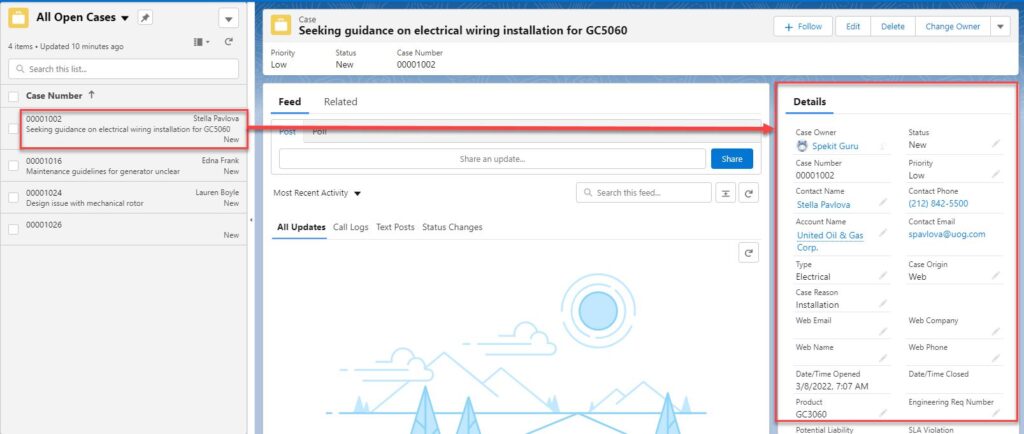Salesforce Lighting List Views
Customize this training to give your revenue team the help they need directly in Salesforce Lighting to maximize productivity and pipeline.
1. Inline Editing List Views in Salesforce Lightning
You can edit some fields directly from a List View without having to navigate to the record itself in Salesforce Lightning.
If the field is editable from the List view, you will see a ✏️ icon

1. Click the ✏️ icon.
2. Edit field values.

3. See edits in yellow.
4. Click Save.

Mass Editing
You can update multiple record fields to the same value at once.
- Check the Left Box for the records that need to be edited.
- Check the top, header box to check all the boxes.

2. Update the field value.
3. Check the Update # selected items box.
4. Click Apply.

5. See edits in yellow.
4. Click Save.

2. Kanban List Views in Salesforce Lightning
You can view a List View as a Kanban board or a visual way of seeing a grouping of a lot of work at once
- Ideal to see records grouped by an Owner or Status.
- Like Cases, Opportunities, or Leads
- Drag-and-drop records between columns (groups) to update the fields.

1. Click the Display As icon.
2. Click Kanban.
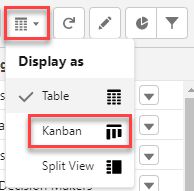
3. The List View will refresh.
- A grouping at the top and a sum just below it.
- A high-level detail of each record.

4. Drag-and-Drop records to update the grouped field.
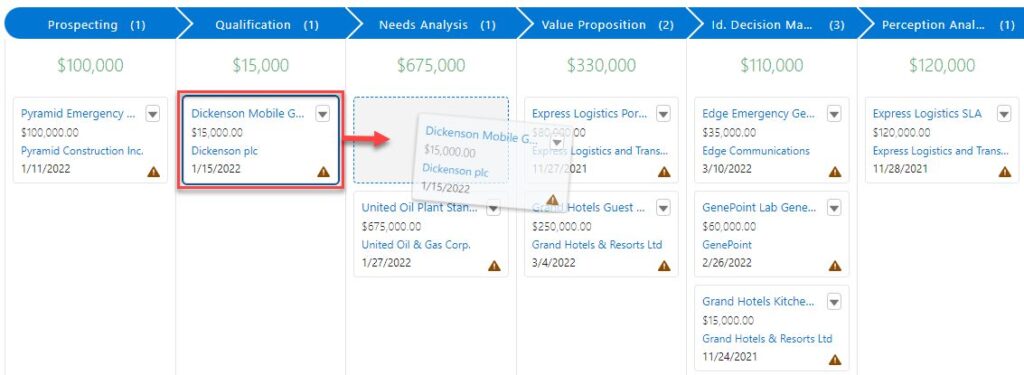
Edit Summed and Grouped Fields
1. Click the List View Controls ⚙️ icon.
2. Click Kanban Settings.
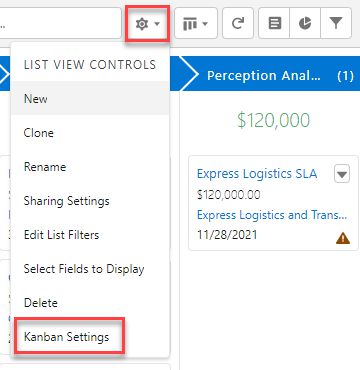
3. Update the Kanban display:
3a. Summarize By
- A Currency or Number to be summed.
- This is not required.
- A Picklist or Owner field.
4. Click Save.

3. List View Buttons in Salesforce Lightning

1. New – Create a Record.
- Search 🔍 for “Create Records” to learn more.
2. Import
- Search 🔍 for “Import Settings” to learn more.
3. Printable View – View the List View in a printer-friendly format and print it.

1. List View Controls –
- Search 🔍 for “List View Controls” to learn more.
2. Display As
- Table (default)
- Kanban
- Search 🔍 for “Kanban” to learn more.
- Split View
- Search 🔍 for “Split View” to learn more.
3. Refresh – Refresh the data displayed.
4. Edit List
- Search 🔍 for “Inline Editing List Views” to learn more.
5. Show Charts
- Search 🔍 for “List View Charts” to learn more.
6. Show Filters
- Search 🔍 for “List View Filters” to learn more.
4. List View Charts in Salesforce Lightning
Add a chart to a List View to make it more visual!

Viewing the Chart
1. Chart Name is at the top. Click the Down Arrow to choose another Chart.
2. Hover over a part of the chart values to see specifics.
3. Click the Gear to change the chart type or create a new Chart.
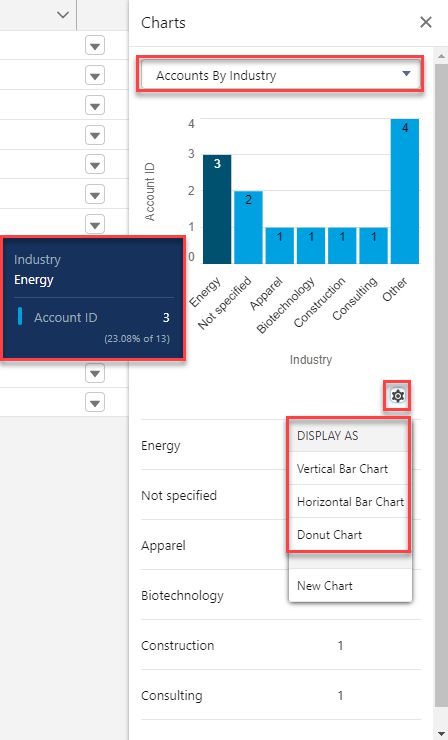
Creating a New Chart
1. Click the Gear.
2. Click New Chart.

3. Enter the Chart Name.
4. Chart Type
- Vertical Bar Chart
- Horizontal Ber Chart
- Donut Chart
- A Donut Chart is a Pie Chart that includes the Total Record Count in the center of the “donut”.
5. Aggregate Type
- Average
- Sum
- Count
6. Aggregate Field
- The field that is being measured on one of the chart axis’: averaged, summed, or counted.
7. Grouping Field
- The field that grouping the records on the other chart axis.
8. Click Save.
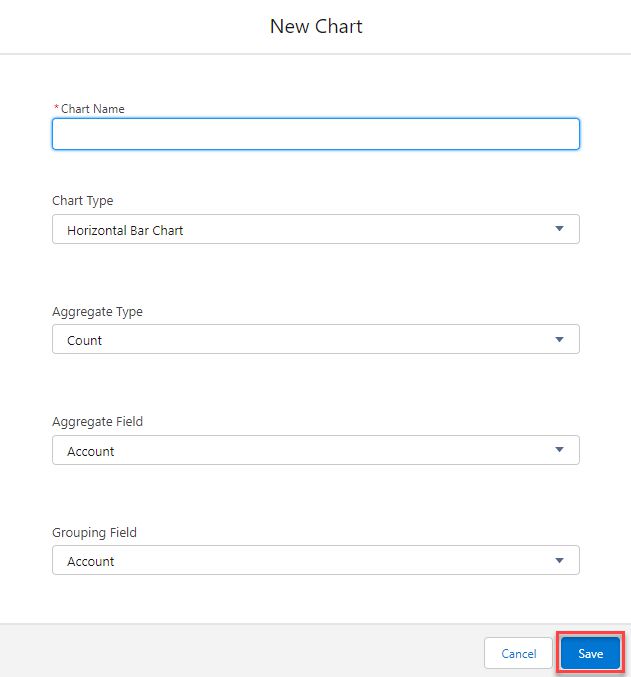
5. List View Controls in Salesforce Lightning
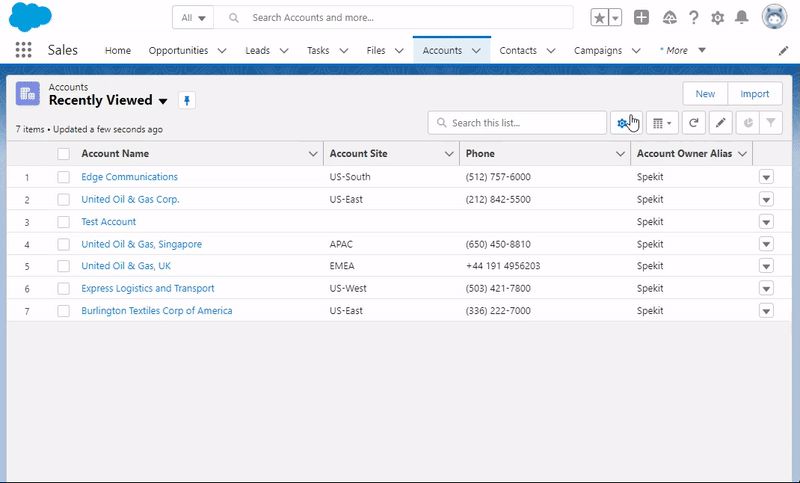

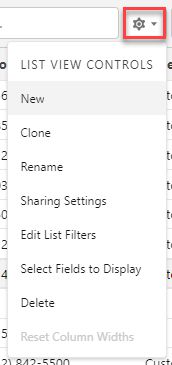
1. New
1a. Enter a List Name.
2a. Select who can view the List.
- Only you
- All users
- One or multiple Groups
3a. Click Save.

2. Clone
If you need a new List View that is only a minor change from an existing one, Clone it and make the minor edit instead of creating it new.
Looks just like creating a New List View above.
3. Rename
4. Sharing Settings
Update who can view a List.
5. Edit List Filters
Same action as clicking the List View Filter icon.
6. Select Fields to Display
6a. Add and Remove Fields
- Select the field
- Click the left or right arrow
6b. Re-order the Fields
- Select the field
- Click the up or down arrow
6c. Click Save.
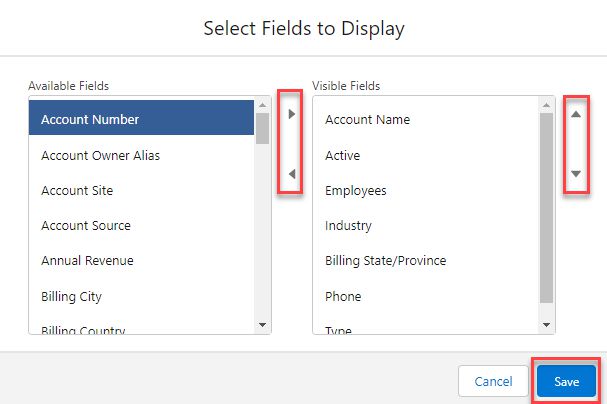
7. Delete
8. Reset Column Widths
If a column is made shorter or larger, this button will reset it to the default width.
6. List View Features and Functionality in Salesforce Lightning
Searching List Views
If the List View has many results, instead of adding a filter, you can Search the List View to limit your results.
- Certain fields cannot be searched. Hovering over the Search bar will let you know which ones.

Column Width
Change column width by hovering over the area between them and dragging and dropping to make the column shorter or longer.

Sorting
Click a column header field name to sort ascending or descending. You can see what field is sorted which way by the arrow to the right of the column name and if it’s pointing up or down.

7. List View Filters in Salesforce Lightning
Add filters to a List View to make your lists easier to work through!
See records that match certain criteria instead of all records for that Object.
Using filters is beneficial to allow you to see only the records you need to work.

1. Filter by Owner
- All accounts will show all accounts.
- My accounts will show the accounts where you are the listed Account Owner.
2. Click Done.

Add More Filters
1. Click Add Filter
2. Select the Field
3. Select the Operator
4. Enter the Value
5. Click Done

6. Click Add Filter for as many fields as you want filter criteria for.
7. Click Save
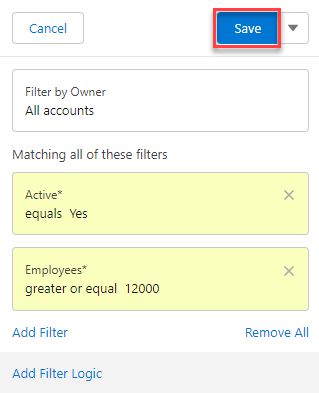
Add Filter Logic
Filter Logic allows you to be more specific in drilling down your results.
1. Click Add Filter Logic

2. By default, Filter Logic is only ANDs, meaning all filters need to be true for the record to appear.
3. You can change it to be 1 OR 2 so that if either result is true for the record it will appear.
4. If you have even more filters you can add more detailed logic including parenthesis.
- i.e. (1 OR 2) AND 3
5. Click Save.
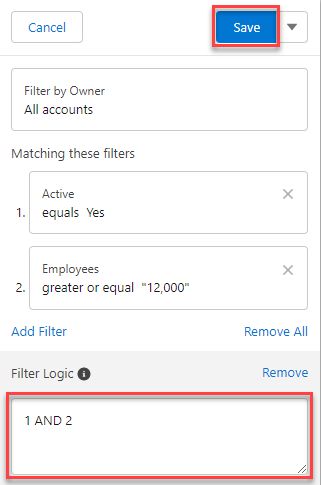
8. List Views in Salesforce Lightning
List Views can be similar to Reports, but only allow you to view information from one Object at a time.
By default, List Views are in the Table format seen below. They can be accessed by clicking the Objects Tab.
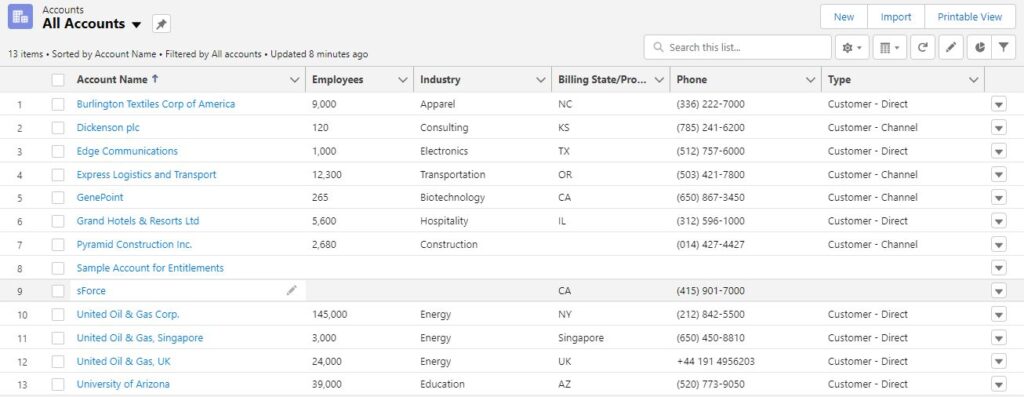
Changing List Views
- The default List View is called “Recently Viewed” and it includes the records you have last been on
for that Object. - The first time you access a new Object the List View may be blank because you have not yet
2. Click the 🔽 icon
3. Click the List View Name to load it.
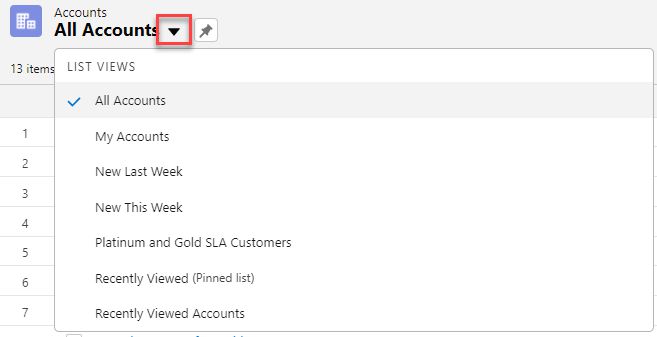
Default List Views
To make your default List View different from “Recently Viewed”, pin a different one.
1. Load the List View you want to be your default.
2. Click the 📌 icon.
- This will be your default List View until you pin a different one.
- This is set by a cookie, so if you clear your cookies and cache, it will clear your pinned List Views.

9. Split View List Views in Salesforce Lightning
You can see a List View in a Split View in Salesforce Lightning
- Ideal to quickly access records in the same tab to save time in clicking back and forth from the List View
- Cases – Review and comment on Cases in your queue
- Contacts/Leads – Review your call list and bring up specific contact/lead details and information during the call in the side panel
- Tasks – Action your to-do list

1. Click the Display As icon
2. Click Split View
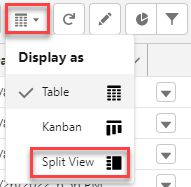
3. The List View will refresh
- The List View on the left and the record detail of the selected from the list on the right
